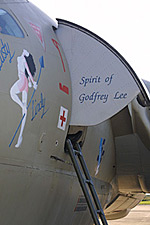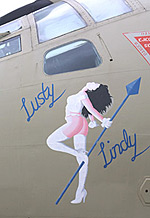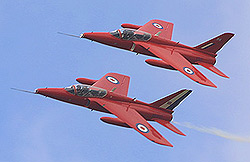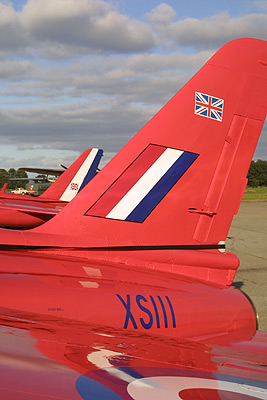Home | Airshows | The Hangar | Nostalgia | Links
|
Labours
of Lindy
|
 |
|
Always a star turn at Elvington is Victor K2 XL231, otherwise known as 'Lusty Lindy'. Sadly Elvington is the only place she can perform, as she remains grounded following retirement from the RAF way back in 1993. Still kept in full working order by a remarkable band of volunteers led by owner Andre Tempest and Victor devotee Roger Brooks, she occasionally struts her stuff on Elvington's long runway, performing fast taxi-runs and releasing her enormous braking parachute. Victor K2 XL231 'Lusty Lindy' was one of 21 Victor B2s produced by Handley-Page at Radlett against contract 6/Acft/12996/CB6(a) (dated January 1956) in 1960. '231 gained her Airworthiness certificate on 31 January 1962 and was issued to 139 Squadron at Wittering on 1 February. Number 139 (Jamaica) Squadron was the first Victor B2 Squadron to enter service, and XL231 was the very first B2 to land enter service, just like her Vulcan cousin XH558 which currently resides at Bruntingthorpe. Tom Muir, an ex-RAF instrument fitter, was there to see her that day. "Having completed training at RAF Melksham as a direct entry Instrument Fitter (General) in December of 1961, I was posted to RAF Wittering to join a re-formed 139 (Jamaica Squadron) in January 1962. On arrival I found that we had a beautiful new hangar, a full complement of staff, but no aircraft! With all our servicing bays, stores etc. organised, it was with great anticipation that we all gathered out on the perimeter track to watch the arrival of our first aircraft. Out of the clouds and in over the A1 she came, heartstoppingly graceful, XL231! Textbook touchdown, brake chute billowing, anti-flash white paintwork gleaming. She looked new, smelled new, and we were so proud of her." She was converted to B2R standard in November 1963 and served with the Wittering Wing until withdrawn on 23 January 1972 for conversion to become the prototype K2 tanker. She later served with 57 and 55 Squadrons at Marham, saw service in the Falklands War, in support of the 'Operation Black Buck' Vulcan raid on Port Stanley, and later in the Gulf War until retirement in September 1993 and subsequent acquisition by the YAM. Flown into retirement at Elvington in November 1993, the aircraft is kept in ground operational condition by Andre Tempest and his ground crew. More recently the name 'Spirit of Godfrey Lee' was applied to the crew door as a tribute to the late HP designer often regarded as 'Mr Victor'. |
 |
|
Sunday's show at Elvington saw a minor drama as a hydraulic leak prevented her from performing on schedule at 13:00, but some running repairs enabled a sunset run to be done after the main flying programme, albeit without the chute. Monday's run went to plan, but to enable the chute to operate, the primary hydraulic system was blanked off and the reserve system used, which was a one shot operation and not guaranteed as it is impossible to test. All went well as can be seen but it will mean many more hours of toil for the loyal support crew, who pride on their Victor being the most complete. Steve Haigh explained that "All systems are kept live - nothing has been made redundant. If a part's needed, we go out and find it." With only five complete airframes left in the UK, four being K2s, parts are scarce as one can imagine, but a recent find of spares at a dealer in Lincoln shows all is not in vain. The only competition for parts comes from British Aviation Heritage who operate XM715 'Teasin Tina' at Bruntingthorpe, the only other 'live' Victor in existence. The elements are perhaps the team's greatest enemy, as Lindy sits outside and the weather takes a toll on the hemp camouflage scheme. A repaint two years ago already shows signs of wear, but while there's a will she will survive. Costs get ever greater with age, not least fuel, but the tanks have enough capacity for a couple of years worth of taxi runs before they need replenishing. The Victor never quite gained the affection that the Vulcan enjoys, so there is no chance of one becoming airborne again, but in the air is where Handley-Page's graceful crescent belongs - she looks most uncomfortable on the ground with her squat undercarriage, unlike the purposeful stance of her Avro cousin. Although she may shuffle to the runway rather grumpily, the unleashing of the four Conway engines brings a smile to her face, as it does the crowd. Long may she stretch her legs in Yorkshire. |
 |
|
With
thanks to Damien Burke's Thunder
and Lightnings site for invaluable help
|
 A
labour of lust
A
labour of lust
Great Yorkshire Airshow, Elvington, 25/26 August
Gary Parsons and Chris Chambers report from Yorkshire's biggest aviation event.
Elvington is another of those great little secrets that you finally get around to knowing, after many years of saying "Maybe next year..." Well, next year finally came, and a well-organised and interesting show was to be found. Okay, so the static was virtually non-existent, but then this is typical of the newer breed of civilian organised airshow that concentrates on a good flying programme. Set adjacent to the Yorkshire Air Museum, it was a shame that some of the museum residents weren't dragged out for the occasion, as the Halifax, Buccaneer and Lightning would have been much savoured by the photographic enthusiast. Museum visitors did have the opportunity to view progress on latest acquisition Dakota G-AMYJ that arrived earlier this year and is in the process of being restored to taxiing condition.
|
The
show
|
 |
 |
 |
 |
 |
 |
 |
 |
 |
 |
 |
 |
 |
 |
 |
 |
 |
 |
 |
 |
 |
 |
 The
closure of RAF Finningley and the downgrading of operations at RAF Church
Fenton in the early nineties resulted in the loss of what had been a pair
of very popular air shows in the Yorkshire region - a void that wasn't
truly filled until 1999 with the first Yorkshire Air Show. The display
is now in its fourth year, growing to become the largest display in northern
England, a stature the organisers are justifiably proud of.
The
closure of RAF Finningley and the downgrading of operations at RAF Church
Fenton in the early nineties resulted in the loss of what had been a pair
of very popular air shows in the Yorkshire region - a void that wasn't
truly filled until 1999 with the first Yorkshire Air Show. The display
is now in its fourth year, growing to become the largest display in northern
England, a stature the organisers are justifiably proud of.
The airshow utilises the recently disposed MoD emergency landing airfield constructed in the 1950s. A long, long 10,000 ft runway and vast concrete apron were supposed to have been used by the USAF in the Cold War but they never turned up, leaving the acres of concrete to the local trainers from Linton-on-Ouse. One problem with the layout is that there is only one way in, resulting in RIAT-proportion delays is getting out of the airfield, as all cars are parked on the massive apron and funnel towards one exit. As a bumper crowd turned out over the two days, this is definitely an area for the organisers to work on for next year. Space isn't a problem once you're in, the ample grass areas between the runway and the taxiway make for a pleasant crowd-free wander amongst the trade stands.
 A
surprise is the location of the flightline - the eastern end of the runway!
Such is the length available that the flying participants are parked at
the far end of the active runway, on the south side, the north side available
in the case of any emergency on landing. It was quite an experience to
see the Tornado F3 thunder towards a line of parked aircraft before rotating
skywards, but the safety margins are considerable and all pilots had no
problem with it. Indeed, such is the length of the runway that the airshow
only occupies half its length, the western half extending into South Yorkshire
and some acts that taxied to the far end were literally out of sight.
As arrivals were made on Sunday morning, the first warning many got was
when the aircraft taxied past after landing some 6,000 ft further down
the runway even after a run and break!
A
surprise is the location of the flightline - the eastern end of the runway!
Such is the length available that the flying participants are parked at
the far end of the active runway, on the south side, the north side available
in the case of any emergency on landing. It was quite an experience to
see the Tornado F3 thunder towards a line of parked aircraft before rotating
skywards, but the safety margins are considerable and all pilots had no
problem with it. Indeed, such is the length of the runway that the airshow
only occupies half its length, the western half extending into South Yorkshire
and some acts that taxied to the far end were literally out of sight.
As arrivals were made on Sunday morning, the first warning many got was
when the aircraft taxied past after landing some 6,000 ft further down
the runway even after a run and break!
 The
static park on the airfield is limited, although growing from the humble
beginnings of a single Tucano. This year witnessed the first international
participation in the form of an AH-64A Apache and a pair of BO-105s from
the Netherlands. Monday's visitors were treated to a rare and impromptu
display by the Apache as the helicopter was repositioned from the static
park to the flight line, the crew taking advantage of the open expanse
to demonstrate the type's manoeuvrability with a short series of flypasts
and turns.
The
static park on the airfield is limited, although growing from the humble
beginnings of a single Tucano. This year witnessed the first international
participation in the form of an AH-64A Apache and a pair of BO-105s from
the Netherlands. Monday's visitors were treated to a rare and impromptu
display by the Apache as the helicopter was repositioned from the static
park to the flight line, the crew taking advantage of the open expanse
to demonstrate the type's manoeuvrability with a short series of flypasts
and turns.
Planned to open the show both days were taxi runs by two of the museum's residents, namely Buccaneer XN974 and Victor K2 'Lusty Lindy'. However, all didn't quite go to plan for either aircraft with the Buccaneer only performing on the Sunday and a chute fault delaying the Victor's Sunday run by some five hours (see right).
 Classic
jets featured heavily in the display with the mighty Sea
Vixen the undoubted star. Making its Elvington debut, the Sea Vixen
fought rain and low cloud en-route from its home at Bournemouth to finally
make an appearance just before the start of the Sunday's flying display,
leaving the audience once again guessing "will she or won't she?".
Once airborne for the display routine the Sea Vixen gave an impressive
display of raw power and noise with a number of high speed passes
and fast climbs, Dan Griffith throwing the beast around as if it was a
fly-by-wire F16. Equally impressive, albeit a little more sedate was a
routine by a pair of Red Arrows colour-schemed Gnats from Kennet Aviation.
Led by ex-Eurofighter test pilot Keith Hartley, the Gnats performed a
close pairs routine before breaking into solo displays.
Classic
jets featured heavily in the display with the mighty Sea
Vixen the undoubted star. Making its Elvington debut, the Sea Vixen
fought rain and low cloud en-route from its home at Bournemouth to finally
make an appearance just before the start of the Sunday's flying display,
leaving the audience once again guessing "will she or won't she?".
Once airborne for the display routine the Sea Vixen gave an impressive
display of raw power and noise with a number of high speed passes
and fast climbs, Dan Griffith throwing the beast around as if it was a
fly-by-wire F16. Equally impressive, albeit a little more sedate was a
routine by a pair of Red Arrows colour-schemed Gnats from Kennet Aviation.
Led by ex-Eurofighter test pilot Keith Hartley, the Gnats performed a
close pairs routine before breaking into solo displays.
Further colour under the threatening grey skies came in the form of Hunter G-PSST, otherwise known as 'Miss Demeanour'. Taking full advantage of Elvington's long runway, pilot Jonathon Whaley performed what must have been the most impressive take off of the weekend. Once airborne, the Hunter accelerated to 230 knots before a hard turn to port put the aircraft in-line with the B-axis of the display line, all right on the allowed display hard-deck! Not quite so energetic was a display by 'Golden Apple' Trust's T-33, Cliff Spink bringing the aircraft as literally a last minute substitution for the F-86 which had suffered from a small fault shortly before it was due to leave Duxford.
Military participation was rather limited this year, but fast jet displays were provided by the 16(R) Squadron Jaguar and 56(R) Squadron's Tornado F3. Steve Simpson made the short hop from nearby Linton-on-Ouse in his Tucano and flying down from Kinloss was a Nimrod MR2. Making a rare UK flying appearance was a USAFE C-130E Hercules, flying over especially from Ramstein to perform a couple of flypasts before departing for home. Unfortunately both passes were rather high, but just low enough to make out the 'Let's Roll' nose-art on the port side.
 Adding
Second World War nostalgia was the BBMF trio of Lancaster, Spitfire and
Hurricane. An opportunity was missed by the Yorkshire Air Museum as Halifax
'Friday 13th' remained in the hangar all weekend, when there was an abundance
of ramp space that would have allowed the Lancaster and Halifax to sit
side by side in scenes reminiscent of 1940s Elvington. Maybe next year?
Also flying was the Royal Navy Historic Flight's Fairy Swordfish - named
the 'City Of Leeds', the Swordfish made its annual pilgrimage back to
Yorkshire having been constructed only a few miles away at Sherburn-In-Elmet.
Also representing carrier borne aircraft, although on much larger and
robust scale was Tony Haig-Thomas's Grumman Avenger, while Rob Davies's
P-51D Mustang 'Big Beautiful Doll' was one of the few types present to
be fortunate enough to have some respite from the low cloud which had
dogged the flying display as, albeit briefly, blue patches appeared right
on cue.
Adding
Second World War nostalgia was the BBMF trio of Lancaster, Spitfire and
Hurricane. An opportunity was missed by the Yorkshire Air Museum as Halifax
'Friday 13th' remained in the hangar all weekend, when there was an abundance
of ramp space that would have allowed the Lancaster and Halifax to sit
side by side in scenes reminiscent of 1940s Elvington. Maybe next year?
Also flying was the Royal Navy Historic Flight's Fairy Swordfish - named
the 'City Of Leeds', the Swordfish made its annual pilgrimage back to
Yorkshire having been constructed only a few miles away at Sherburn-In-Elmet.
Also representing carrier borne aircraft, although on much larger and
robust scale was Tony Haig-Thomas's Grumman Avenger, while Rob Davies's
P-51D Mustang 'Big Beautiful Doll' was one of the few types present to
be fortunate enough to have some respite from the low cloud which had
dogged the flying display as, albeit briefly, blue patches appeared right
on cue.
As with previous years, there was an abundance of aerobatic teams on hand, but with the Red Arrows absent en-route to Canada, the role of formation jet aerobatics went to Team Khalifa, making only their third UK appearance as a four-ship in blue and yellow L39s. Although relatively underpowered in comparison to other modern day jet teams, the Khalifa team offered some close formation flying and solo routines. It is planned to increase the team to a six or even seven ship next year, offering even more opportunities for aerobatic routines and formation flying. Not quite so fast were the Yaks of the Yakelov display team who like most teams were limited to a rolling display with the low cloud.
Display pilot Denny Dobson performed his usual act of controlled madness in a routine which included flying under a ribbon which had been suspended only twenty-five feet above the runway, before as a finale he used the prop of his Extra 300 to cut it. Pushing even further were team Alpine, pilot Will Curtiss in his SU-26 performing what was probably the most punishing routine with manoeuvres ranging from -7G to a blood draining +12G (the SU-26 is stressed to a huge +/- 23G, breaking the pilot long before the airframe!).
 So,
next year, make it the one you actually go - just be prepared to do the
museum in the evening and avoid that queue battling to get out!
So,
next year, make it the one you actually go - just be prepared to do the
museum in the evening and avoid that queue battling to get out!
For more pictures visit Warplane
Home | Airshows | The Hangar | Nostalgia | Links